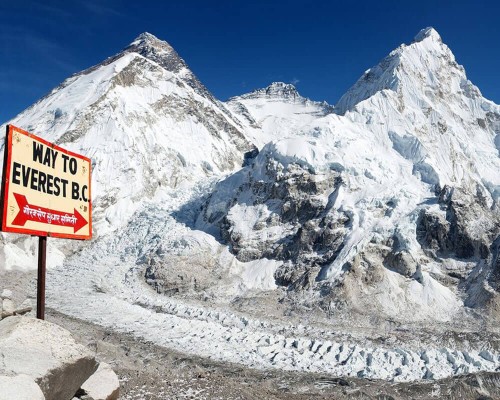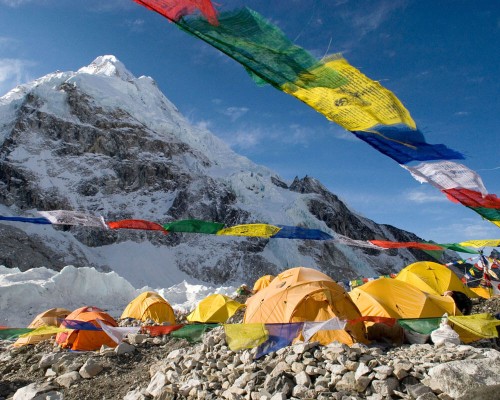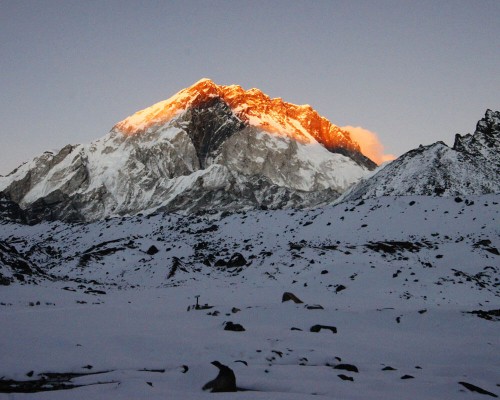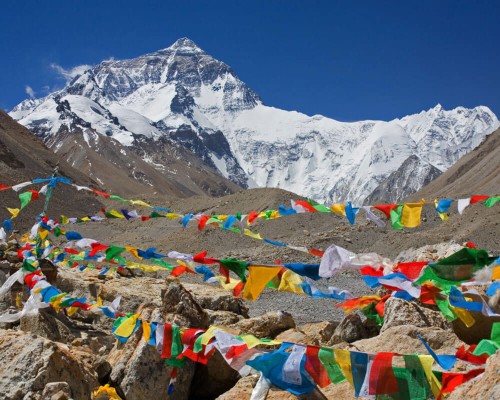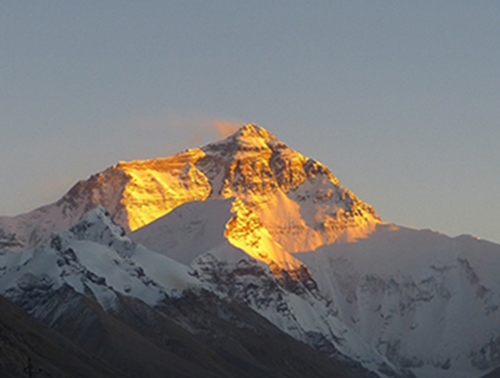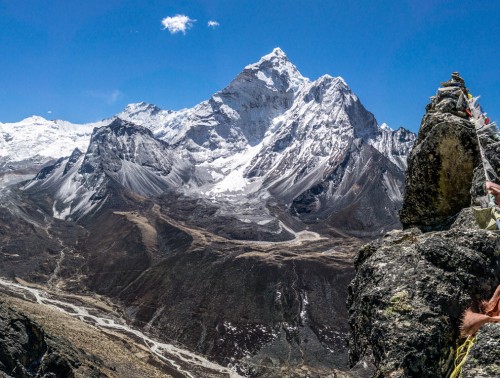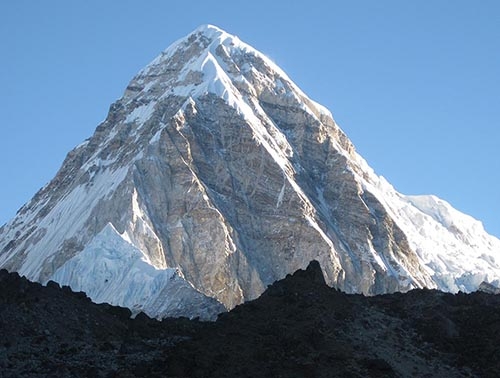Trip Grade: Fitness level and Health
Everest Base Camp Trek is one of the toughest treks in the Everest region. So, trekkers must be in good physical condition and mentally strong to be prepared for the challenging trek. For that, you have to begin hiking at least once per week for 8 to 12 weeks duration before your trek by carrying a heavily weighted backpack and exercise to train your body by improving cardio endurance, focussing on building strength and stamina.
Moreover, if trekkers have any previous trekking experience such skills can come in handy as well. In this trek, the difficulties can change depending on weather conditions and various circumstances. The trek routes are demanding as they involve a steep descent and a steep forward trail in the forest and the rocky path as well as long climbs. So, the more vigorous you are, the more gratifying your trek will be.
You will be hiking for 5 to 7 hours a day, depending upon the destination and we will take a small break for meals. Also, admire the beautiful mountain scenery.
We request you inform us if you have any pre-existing medical conditions related to heart and lung diseases that will lead to a more serious outcome. So, do consult your doctor before planning for this trek.
Safety Precaution for Everest Base Camp
Everest Base Camp Trek has always grabbed the attention of adventurers, mountaineers, thrill-seekers, and rock climbers all around the world. The trails are demanding at some point; nevertheless, the Eternal Himalayas will make sure to take care of their clients and make them feel secure, comfortable, and safe throughout their journey.
Our guides have undertaken intensive Wilderness First Aid Training.
- Trek leaders/Guides are very professional in their work and can tackle any difficulties.
- Carry first aid boxes which contain necessary medication, good quality gloves, masks, sanitisers, bandages etc.
- Throughout the trek, they will motivate and encourage you.
- Keep tabs on Food and Accommodation for hygiene.
A typical day on Everest Base Camp Trek
Every day you will encounter a new adventure on the trails of the Everest Base Camp trek. You will enjoy the spectacular sceneries, explore new nearby places on the way and take memorable pictures. Moreover, you will be visiting traditional local settlements and historical and religious places.
From the start to the end of this trek, our friendly and well-trained guides will escort you. They will provide you with all the necessary info and historical facts related to the places which you will be visiting.
Our porters will carry the luggage for you. But we recommend you carry your valuables and important documents in your separate backpack by yourself.
The day will always start with an early morning breakfast. After that, we will pack all our bags and set out on a day trek from around 7 am to 8 am, which depends upon the trek's nature and duration. Then after hiking for three to four hours or more, we will take a break to have lunch, rest for about an hour, and carry on the trek.
Generally, afternoon walks are shorter for about two to three hours. Right after we reach the lodge/teahouse we will fuel our bodies with dietary food, and explore nearby places.
Dinner will be served between 6 pm to 7 pm. After dinner, you can relax and enjoy yourself by having friendly conversations with your teammates. Then your trekking guide/team leader will give a briefing about the next day's plan. After that, you can go to bed or play some board games or watch whatever is available.
Accommodation Details During The Trek
The Everest Base Camp trek is 11 days long if we exclude the arrival, preparation, and departure days. For this exhausting journey, we will be staying at the best service-providing lodges as much as possible.
In Lukla, Phakding, and Namche (2 nights for an acclimatization rest day ) you will be staying at a guest house/lodge where they have a private room with an attached bathroom. Whereas at Thame, Lumde, Gokyo (2 nights), Zhongba, Lobuche, Chukung, Gorak Shep, Thangnak, and Pheriche you will be staying in standard rooms or dormitory-style rooms in most places. At these places, you will be sharing rooms and bathrooms with other guests.
Most lodges above Namche don't have an attached bathroom but some lodges of Dingboche and Pheriche do have attached toilets but bathrooms are separately built. Before and after the trek you are staying at a hotel in Kathmandu, which is included in the package. During your stay in Kathmandu, you can choose a wide range of hotels of your liking and budget.
Facilities of wi-fi connection and hot showers are also available for an extra cost during the trek.
Nepal Tourist Visa Info
All foreigners, excluding Indian nationals, will require a visa to enter Nepal. However, European countries can obtain visa-on-arrival at the Tribhuvan International Airport, Ktm, Nepal.
Passport validity is required for at least 6 months and should be beyond the total duration of the trip. Also, require a passport-size photo for visa application. The cost of a Nepal Tourist Visa differs according to the number of days it is issued. The Nepal Tourist Visa fee is USD 30 for up to 15 days. For up to 30 days the visa costs USD 50 whereas the visa fee for 90 days costs USD 125.
Citizens of SAARC and China will receive a free visa. Some countries' citizens may not receive an on-arrival visa and these countries are Ghana, Swaziland, Cameroon, Liberia, Ethiopia, Palestine, Nigeria, Zimbabwe, Somalia, Afghanistan, and Iraq. Therefore, nationals from these countries can contact their local Nepalese embassy.
For more information related to visas search at https://www.immigration.gov.np/
Acclimatization During Everest Base Camp
Namche and Dingboche are the two places where we will be acclimatizing for 2 nights in each place. Trekkers who rapidly ascend to high altitudes can suffer from altitude sickness. Altitude sickness can be fatal, hence we cannot skip the acclimatization days.
Our client’s health and safety are our topmost priority. So our guides will frequently keep checking up on your health and provide the necessary treatment for altitude sickness if needed.
If you are in a serious condition, the only cure is for you to descend as soon as possible. For such cases, your group leader has the authority to decide whether to continue the trek or descent right away.
Related packages
Everest Base Camp Trek - 14 Days
Everest Three Passes Trek
Everest Basecamp with Island Peak Trek
Rolwaling Tashi Lapcha Pass Trek
Mera Amphu Lapcha Island Peak Trek
Everest Short Trek
Mani Rimdu Festival Trek
Everest Panorama Trek
Everest Basecamp with Cho La Pass Trek
Gokyo and Renjo La Pass Trek
Everest Base Camp Luxury Lodge Trek
Jiri to Everest Base Camp Trek
Everest Basecamp fly back by Helicopter
Gokyo with Cho La Pass Trek
Mountain Flight-Everest
Related blogs
Everest Base Camp Trek Distance
Everest Base Camp Trek Difficulty A Comprehensive Guide
7 Best Everest Base Camp Trekking Packages in Nepal
Reasons to do Helicopter Tours in Nepal
Nepal’s most exhilarating mountain passes
Foods and Accommodations during EBC Trek
Everest Base Camp Altitude Sickness
Everest Base Camp Trek in December
Everest Base Camp Helicopter Tour
Everest Base Camp Trek Fitness Requirements
Experience the Everest Luxury Lodge Trek
Everest Base Camp Trek Difficulties
Best Time to Visit Everest Base Camp
The weather plays a vital role in executing a successful trek.
Spring (March-June) and Autumn (September-November) are the most ideal times to trek as the weather conditions are stable during these seasons, the skies are clear and there are very few chances of rain. However, Eternal Himalaya conducts the Everest base camp trek all year round. Even Locals and Adventurers trek on Everest regions throughout the year, if you consider the safety and fewer challenges then you should choose the right time to trek.
As the trek gets more challenging in unfavourable climatic conditions during winter and monsoon, some risk-takers aren’t bothered by bad weather. Trekkers do visit during winter too but make sure to bring extra base layer clothing because it’s extremely cold.
January to February
Especially from early January to February, the temperature is at its coldest mostly at night time with heavy snowfall. As it is considered to be the coldest season. We do not recommend trekking during these months, especially for those who are allergic to colds. In winter there will be limited crowds in general.
The temperature rises and falls between 15°C to -15°C.
March to April
March is the beginning of the Spring season, the weather becomes warm with moderate temperatures and various rare and unique Himalayan flowers bloom during this time. It is the busiest trekking season and also one of the best seasons to trek for the Everest Three Passes. At this time, you can enjoy marvellous landscapes such as spectacular views of Himalayan ranges and glaciers.
The temperature rises and falls between 18°C to -12°C.
May to June
It is also the perfect time to trek before the monsoon season. During May, the days will be longer and the weather becomes sunny and warm while from the end of June till mid-August Nepal will receive rainfall. The spring and summer season makes the trek much more comfortable and enjoyable.
The temperature rises and falls between 25°C to -5°C.
July to August
During this time the rainfall reaches its peak at an altitude below 3500 meters. So, there is a high chance that the flight to and from Lukla may get cancelled or delayed by heavy rainfall. Despite these obstacles, you will still meet other trekkers on the trails. Because of heavy rainfall, the flow of the water increases resulting in a stunning view of the waterfall. The Everest Three Passes gets a bit challenging because you have to trek through the rain with limited views, it's probably best to avoid this time but not impossible to visit.
Eternal Himalaya does organize treks in the monsoon season. The temperature rises and drops between 27°C 5°C.
September to October
This is also the most popular season for the Everest Three Passes Trek since the monsoon will come to an end and the sky will be clear with stable weather conditions. This is the perfect season for those who are looking for an undemanding Everest Three Passes Trek.
The temperature rises to 20°C in the daytime and falls to 5°C at night.
November to December
Since the winter slowly approaches, snowfall begins and Night gets colder in the Himalayan region which eventually makes the trekking difficult to accomplish. Despite these difficulties, November still is a busy season. The days are sunny and bright with clear skies to enjoy the awesome views of huge mountains but cold during night time so a sleeping bag is most important.
From December, the weather will be foggy and cloudy. The temperature starts to fall and gets cold, also heavy snowfall starts. The maximum temperature in the daytime is 18°C and the minimum temperature is -10°C at night. The weather is unpredictable in the Himalayan region so, temperature and weather conditions may change quickly.
Language
Namaste (hello) and dhanyabad (thankyou) are the two words you generally need. Don’t worry about the language barrier. You will be accompanied by an Eternal Himalaya’s skilled guide whom you can rely on for translating language and communicating with locals.
Meals During Everest Base Camp
Eternal Himalaya hand-picked the fine lodges/teahouses to serve you nutritious, fresh, hygienic, and delicious food. Lodges and teahouses are scattered throughout the Everest region along the base camp trail. Many of these lodges will provide you with a variety of local traditional and Asian as well as Western cuisine. But as you climb higher, the menu in high-altitude lodges has limited options and the cost of food increases along with the altitude. However, food is far more plentiful than you can imagine on the way to three-pass treks. They served hot meals and beverages too. We highly recommend you keep your body hydrated throughout the trek, it will prevent you from altitude sickness. You can take a lot of liquids in the form of tea (hot lemon tea, ginger tea, green tea) and soup (especially garlic soup).
Avoid intake of alcoholic drinks, dairy items, hot chocolates, and caffeinated items during the trek.
The lodge’s menu consists of both veg and non-veg items. Despite the availability of meat items in trekking regions, we do not recommend them to you all. Since the meat in these regions is not hygienic enough to consume, it's better to eat fresh vegetables (veg items) throughout the trek.
Electricity for recharge and drinking water facilities on the trek
Many of the Lodges throughout the Everest region will provide you with the electricity to recharge your phone, camera, or any electronic devices and batteries for a minimal service charge.
In the course of trekking, pure drinking water is very essential. Nonstop, your body will be in desperate need of water to resist the effects of altitude sickness and dehydration. If you are looking for purified drinking water, boiling water is the best solution. The lodges and tea houses also sold boiled water, you can refill your water bottle with the boiled water at an extra cost per litre. There are other ways to filter your water too, by simply filling water from taps and using water purifying tablets or drops, portable water filter gadgets or bottles, etc for free of cost.
Our Eternal Himalaya guide can provide you with water purification tablets in case you need them. Although there are many ways to get access to clean drinking water, the most effective one is through boiling. You can also buy mineral water from local shops and lodges on the way.
Do not drink untreated water directly from the taps, rivers, wells, or any water resources in the Everest region because it can cause diarrhoea and illness.
ATM / Money Exchange
Most of the foreign currency can be exchanged through a local bank and legitimate money exchangers found around Kathmandu and the Thamel area.
Ongoing exchange rates of all foreign currency are displayed by the legal money exchangers for the public. Please be informed that in Nepal Indian currency of INR (Indian Rupees) 100 and INR 2000 notes are only used. Eternal Himal also accepts foreign currency as a payment.
ATMs are available all over Kathmandu but the best place to go for ATM is around Thamel area of Kathmandu. You can withdraw cash in Nepali rupees only. The maximum withdrawal amount limit is often between NPR 10,000 and NPR 30,000 (approximately between USD 100 and USD 340) if you use a foreign card. Also, most ATMs charge a fee per transaction for their usage. Many ATMs are open 24/7. If you exchange money through banks and financial institutions, they will charge a service fee of about 4% or more.
There are some ATMs available in Lukla and Namche Bazaar (Everest Base Camp route). However, they are not reliable. There are chances these ATMs might not work. We recommend that travellers exchange their money in Kathmandu to avoid any inconvenience while trekking. In the Himalayan region, 95% of places don’t accept cards and only accept Nepalese currency from the local owner and shopkeeper. So, bring a sufficient amount of cash and ensure to bring enough money for your personal expense requirements.
Please ensure that you have clean, new notes for money exchange because most established banks in Asia do not accept torn, old or faded foreign currency notes.
Hot shower and Laundry service on the Everest Base Camp Trek
Hot shower facilities are available throughout the Everest region lodges but you have to pay extra for it. Travelers can get a hot shower facility up to Gorak Shep village which is close to Everest base camp. Most of the places have a gas geyser for a hot shower in the bathroom. At some places, they will provide you with a bucket full of hot water known as a bucket shower. Generally, at high-altitude lodges, bathrooms are outside and shared by other guests too. Above Namche, you won’t get proper running water because the water pipeline will freeze because of cold temperatures. A hot shower for one person can cost between US$ 4 to 15 peruse. The cost of a hot shower increases based on the height of the place.
Lodges do provide laundry services but are only available till the Namche bazaar. Above Namche Bazaar there is no laundry service provided by the lodges. So, self-hand washing is the only solution. Travellers can wash their clothes in the sink of the lodge where they are staying. They can either wash their clothes near local taps.
Travel Insurance for Everest Base Camp Trek
Everest Base Camp Trek is full of adventure and along the way, your journey gets exciting and a bit challenging. With these great adventures and challenges come potential risk factors such as altitude sickness, other unforeseen events, sudden climate change, natural disasters like avalanches, etc. The risks involved during trekking are unpredictable, so it’s better to have travel insurance ready before booking the trek. All the trekkers are required to provide a copy of their complete travel insurance policy to Eternal Himalaya. The policy of travel insurance must cover emergency medical and medical repatriation - including helicopter rescue and evacuation expenses at high altitudes (up to 6,000m).
Eternal Himalaya does not sell insurance policies. However, we can recommend insurance companies to assist you based on your (client’s) experiences.
Our clients must send their detailed insurance information after booking the trek. In case of emergencies, Eternal Himalaya will use your insurance policy and information documents to deploy a helicopter to bring you back safely from high altitude. These travel insurance documents help us to quickly arrange rescue operations effectively, transfer for emergency medical help, etc. Please make sure to check whether your insurance policy includes the cost of mountain rescue service while trekking at the highest elevation. Before buying travel insurance, the clients must call and recheck to ensure that insurance companies have helicopter rescue and evacuation up to 6000m. Don't trust what insurance companies have shown on their websites.
WI-FI / Internet services and Communication during the trek
Normally, once you get above Namche Bazaar it will be hard to get free Wi-Fi services. However, you can buy a card from the stores and lodges with passcodes accessing the “EVEREST LINK” wi-fi network but these cards may not be available in some stores and lodges. These cards could cost a lot and are an expensive way to get wireless internet.
Mostly, lodges turn off the electricity at night after a certain time so, you won’t be able to use wi-fi at its fullest. So, be sure to buy a card ahead of time.
The best option for the trekkers is to purchase a Ncell SIM card and data bundle in Kathmandu. It will provide you with reliable connectivity almost everywhere you go. For safety purposes, it's better to use phones at high altitudes. The phone signal depends on the network of the area which may or may not be strong enough. Eternal Himalaya will be in contact with the trek leader of the trekking team almost every day and keep tabs on the trekking updates.
Extra personal expenses during the Everest Base Camp Trek
During your stay in Kathmandu, accommodation with a bed and breakfast basis for four nights is covered by the package but clients will be required to pay for lunch and dinner by themselves.
Although the package covers the cost of standard meals (Breakfast, Lunch, and Dinner with beverage per cup ) while trekking, you will need to pay the price for extra snacks and beverages - cold drinks, wine, tea, coffee, mineral water, etc. Tips for guides and porters are also excluded from the package. If you want to tip them for the good service you can but separately through your expenses. Besides that, clients will require money for international airfare, Nepal tourist visa fees, and travel insurance.
In the trekking region only Nepali currency is accepted by the local vendors, so bring your foreign currency and change it into Rupees in Kathmandu. We advise you to bring enough cash (Nepali Rupees) for your expenses while trekking because while trekking, you will need money even for basic facilities such as a hot shower, recharge, wifi, and boiling water for drinking.
Trekking in Group/Single
Our company arranges both private as well as group treks. Group discount availability is dependent on the number of team members. For better clarity please visit the price list.
We can manage groups of different sizes. If your group has more than 10 team members you will need an assistant guide to handle the large group. Normally, the group consists of a team leader (guide), one porter for two trekkers, and an assistant guide for a group of more than 10 trekkers. According to our company policies, a group which consists of more than 5 trekkers for the trek is eligible for a group discount. The bigger the size of your team, the lower will be the cost.
Please note that you are required to pay an additional price for the assistant guide.
Immunization Certificate
Foreign Nationals clients including natives (Nepalese) are required to submit the immunization certificate for Covid-19 vaccination. We care for our client’s safety and well-being. It’s a humble request to all our valuable clients to submit a COVID-19 Vaccination Certificate because of the rising COVID-19 cases.
Please be informed that everyone must submit the COVID-19 immunization certificate. We request you inform us if you have any pre-existing medical conditions related to heart and lung diseases that will lead to a more serious outcome. So do consult your doctor before planning for this trek.
Responsible Everest Base Camp Trek
Eternal Himalaya has been collaborating with the Kathmandu Environmental Education Project (KEEP) to reduce the negative impacts associated with environmental degradation. We are eco-conscious about the growing environmental pollution of the Khumbu region. We organize safe and ecologically sustainable treks by providing education, and methods and raising awareness to protect the unique ecosystem of our country.
Eternal Himalaya Hiking Team
Our expert guides will escort you throughout the trek to make your journey enjoyable and comfortable. Every single guide of our company is well-experienced, trained, and licensed. They have been climbing and trekking by leading a group for many years.
All of our crew members have what it takes to lead a successful trek. We value our staff members and take good care of them. Each staff member is provided with good payment, insurance coverage, necessary equipment, gear, meals, transportation, and accommodation during the trek. Medical care is also provided by us in case of an injury or illness.
Our crew members' qualities are:
- Excellent interaction skills and fluency in English and other major languages)
- A certified Trekking Guide
- Knowledgeable about the facts and keep track of weather forecast
- Well-trained in Rock climbing
- Undertook the Biodiversity and Conservation course
- Wilderness First Aid Training
How much luggage can I take during Everest Base Camp Trek?
The weight limit of the luggage is 9 kg per trekker. We abstained from carrying more than 18kg by our porter because one porter carried two trekkers’ luggage at the same time. If you want to bring more luggage with you, we can arrange an extra porter for that. We request trekkers carry their essential documents and valuables in a separate personal daypack.
Eternal Himalaya provides storage facilities for your excess luggage for free.
Before starting the trek we will recheck all equipment, gear, and essentials during a briefing to reassure and verify everything for your convenience.
Tipping in Nepal
Travellers can be rewarded with tips at their discretion based on the quality of services provided to them. As a part of our Nepali culture, Nepalese people accept tips as a way to express their appreciation.
Due to Western influence in the trekking sector, trekking staff such as porters and guides have become accustomed to expecting a tip from clients. If you’ve had good service and a wonderful experience during the trip and want to tip our porters and guides, we recommend giving tips collectively as a group at the end of the trip.
Safe Booking Payment Gateway
Eternal Himalaya Adventure Pvt. Ltd is a well-certified trek and tour company in Nepal and also, a member of the Nepal Mountaineering Association (NMA) and the Trekking Agency Association of Nepal (TAAN). Therefore, you can safely book and pay with us for your preferred trip package without any doubt.
To book a trip first and foremost you have to fill up a booking application form then while booking you are required to pay 20% (non-refundable) in advance for booking confirmation before the trip. Please note that you must send all necessary documents such as passport-size photos, passport copy, travel insurance policy, and arrival and departure flight details within a week after booking.
The convenient and safe ways to pay are through bank transfer and online payment. The remaining cost of the trek can be paid in cash or by bank transfer before the beginning of the trek. Moreover, we will also forward the payment details in your email and vice versa. While filling out the booking application form, the clients must mention the details about modes of payment clearly and should provide all the required details about the credit card.
Last-minute booking on Everest Base Camp Trek
Booking is the best way to execute the whole trip without any hassle. However, Eternal Himalaya does provide a last-minute booking facility for those who are unable to book in advance. For this clients are required to pay 100% of the trip cost within 24hrs before the trip departure.
In case of last-minute booking, we cannot be responsible for the delays because of the events which are beyond our control, such as weather changes, unavailability of lodges and other unfavourable conditions which lead to trip delays and flight cancellations. Despite these unfavourable circumstances we do our best to manage a trek at any time.
For more information, call us at +977 9851254672 (Ram Sharan) or email us.
Trip extension
If you want to stay a couple of days extra in Nepal, after completing your trek. We recommend you use your spare time to explore Kathmandu Valley and neighbouring places. We can provide you with a lot of options such as enjoying adventure activities - Bungee jumping, rafting, zip-flyer, cycling, and paragliding.
Feedback
You may want to give us feedback about our services after completing your trek. Please feel free to react and comment whether it is a positive or negative response we will take it as constructive criticism. After completing your Everest Base Camp Trek, our company will organize a farewell dinner and present you with a trek completion certificate.
Equipment list for Everest Base Camp Trek
Here is the complete essential list of equipment for the Everest base camp trek. The weight of your luggage is limited up to 9 kg, so, therefore, we advise you to carry only essential items. In case you require to carry more than 9 kg, we can arrange porters.
Head Wear
- Warm insulated winter hat / Wooly hat
- Sun hat / Wide-brimmed hat
- Scarf
- Neck gaiter or Fleece Buff (Optional)
- Neoprene face mask (Optional)
- Balaclava / Bally ski mask / Monkey cap (Optional)
- LED Headlamp × 2 and spare batteries
Face/body care items
- Sunscreen with SPF above 50
- Sunglasses with UV protection × 2 pairs
- Face/body cleansing wipes (biodegradable wipes)
- Moisturizer lotion for face/body
- Lip balm
Hand Wear
- Liner gloves × 2 pairs
- Fleece gloves × 2 pairs
Body Wear
- Hiking shirts × 2 pairs
- Full-sleeved thermal undershirts × 2 pairs
- Fleece jacket
- Waterproof and windproof hooded rain jacket
- Down jacket (thick down jacket for winter treks)
- Polypropylene underwear × 5-6 pairs
- Synthetic material hiking pants × 2 pairs
- Long johns × 2 pairs
- Sweater
- Waterproof jacket and pants
- Lightweight cotton pants
- T-shirt
Foot Wear
- Woollen socks × 6 pairs (thick light socks)
- Lightweight shoes/scandals
- Hiking Boots
Essential Gear
- Backpack
- Day pack for basics
- Waterproof covers for your bags and packs
- Thermal water bottle (hydration bladder often freezes in winter)
- Sleeping bag (rated at least 0°C for summer and -15° for winter)
- Water purification tablets, drops or portable water purifier/filter bottles or, gadgets
- Trekking pole
- Crampons
- Large plastic bags and stuff sacks
Personal Toiletries
- Medium size towel
- Toothbrush
- Toothpaste
- Biodegradable bar soap
- Deodorant
- Nail clippers
- Small mirror
- Toilet papers
- Shampoo
Personal accessories
- Money
- Watch
- Cell phone
- Camera
- Lighter
- Pocket knife
Extra items / Travel gear
- First aid kit
- Extra passport photos and photocopies of passport Travel insurance documents
- Notebook and pen
- Books
- Personal entertainment
- Binoculars
- International electrical adapter


.jpg)



